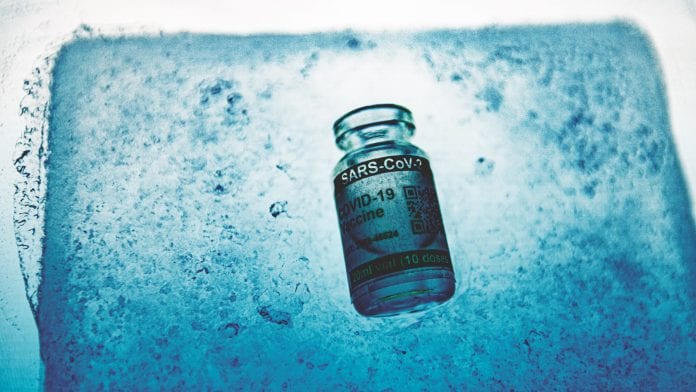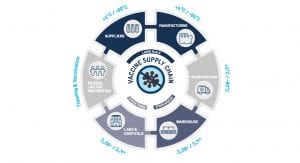
HEQ speaks with AREA President Marco Buoni about the role of refrigeration and the cold chain in combating the COVID-19 pandemic.
The cold chain is a key facet in the storage and distribution of vaccines. As a growing number of vaccines protecting against COVID-19 infection have launched, each with its own individual storage needs, policymakers, healthcare providers and industry stakeholders have scrambled to shore up the cold chain infrastructure to meet the sudden, extensive demand.
HEQ speaks with Marco Buoni, President of the European Association of Refrigeration, Air Conditioning and Heat Pump Contractors (AREA), about the role of refrigeration and the cold chain in combating the COVID-19 pandemic.
What is the role of AREA within the European refrigeration sector?
AREA is the European Association of Refrigeration, Air Conditioning and Heat Pump Contractors. Contractors are the essential link between end users and manufacturers. They design, install and maintain refrigeration, air conditioning, and heat pump equipment using every available solution with complete neutrality towards equipment and refrigerants, with the sole aim of ensuring the highest level of reliability, energy efficiency, and cost effectiveness.
AREA helps its members achieve the highest levels of competence; provides information; participates in events; and co-ordinates with other associations to help decision-makers and EU institutions based in Brussels to draft laws regarding our sector and the benefit it brings to society.
The EU has an ambitious target of reaching carbon neutrality by 2050 and reducing greenhouse gas emissions by 55% by 2030 through the European Green Deal. We are one of the main actors in this revolutionary transition, because the systems our members deal with consume 20-25% of all EU electrical bills.
Refrigeration, air conditioning, heat pumps, and ventilation are viewed separately by the general public, but in reality they are one large sector whose operators, customers, manufacturers and contractors all work together to ensure the refrigeration system is at its most efficient and reliable.
Today, we are experiencing something unexpected and unforeseen. Now, more than ever, we understand how important and essential refrigeration is for modern life. Cooling is critical to fulfilling the most immediate needs of European citizens in preserving food and medicines, providing thermal comfort in hospitals and homes, keeping data centres running, and much more. In this context, the contractors, represented by AREA, play an essential role. They allow the cold chain to operate and the internet to function, and they support healthcare.
This year more than ever, we have witnessed that technicians play a key role in everyone’s lives: thanks to their work, facilities such as supermarkets, hospitals, and other businesses are able to run and provide us all with essential services.
Our sector, including all the operators and contractors working in the cold chain, refrigeration, and air conditioning in general, has been essential in the past difficult year for several reasons, in particular:
- From the harvest to the store, through to the final customer’s table, every food item needs a specific and controlled temperature to keep its organoleptic characteristic and preserve its quality
- Pharmaceutical producers have made an enormous effort in a short space of time to provide a variety of powerful vaccines against COVID-19 for the population to get out of this dark period. Now the effort has moved to the logistical aspect, which is the critical link of the cold chain
- From various studies, we know that COVID-19 is a strong and contagious respiratory pathogen with airborne transmission. For this reason, ventilation and fresh air circulation design are vital for preventing the spread of the disease. Our technicians are doing a tremendous job to change and redefine the configuration of the plants with this in mind
What is the significance of ensuring the cold chain remains intact when transporting and storing vaccines?
Intergovernmental organisation the International Institute of Refrigeration (IIR) set a common and universally recognised definition for the phrase ‘cold chain’: a series of actions and equipment applied to maintain a product within a specified low-temperature range from harvest/production to consumption.

The weakest link is the transport, where the goods – in this case, the vaccines – are loaded and unloaded and the cooling capacity to keep them refrigerated could be insufficient. This could be due to circumstances such as degradation due to vibrations, human error by non-specialist personnel, high ambient temperatures, and other issues likely to occur in transit.
In the case of vaccines, a further difficulty comes in keeping some at ultra-low temperatures: transport-refrigerated ultracold technologies are not as widely and economically available as standard refrigeration; and while dry ice is a feasible refrigeration option, it is subject to the limits of a static passive system.
Pfizer, which needs to be refrigerated at -70°C, was the first vaccine to be deployed. The company eased the issue of temperature by allowing direct shipment to the point of vaccination in an isothermal shipper, called a ‘cool box’, which maintains the ultra-low temperature required for up to 10 days unopened.
What are some common errors in vaccine storage and handling? Is specialised training needed or advised for people handling or transporting vaccines?
In the past 15 years, training and competence in the refrigeration systems sector have improved, due to a European regulation introduced in 2006. The regulation outlines a theoretical and practical assessment for all types of intervention, including installation, maintenance, repair, and the need for a mandatory periodical inspection of the systems. All stationary systems for vaccines and all refrigerated transport above 3.5 tonnes fall under this regulation.
A recent review of the regulation will probably introduce the same provisions for all types of transport refrigeration, which, considering the high value of the goods carried, are even more important if less easy to control, due to the changing legislation across countries.
Several certification programmes are available across the countries, the most important being the United Nations treaty ‘Accord relatif aux transports internationaux de denrées périssables et aux engins spéciaux à utiliser pour ces transports’ (‘Agreement on the international transport of perishable foodstuffs and on the special equipment to be used for such transport’, or ATP), which applies to food and for pharmaceutical products such as vaccines.1
National certifications are also available, primarily concerning temperature control through data loggers and compliance with the requisite level of competence of the personnel involved.
Can you tell me about some of the work that AREA is doing alongside policymakers and national authorities to ease the rollout of the COVID-19 vaccine?
Every EU Member State has a national plan for the logistics, distribution, and administration of vaccines. AREA members have had varied responses: some have spontaneously volunteered to help, providing guidelines and increasing awareness of the cold chain throughout the value chain. Due to the sensitiveness of the product, this will help to save millions of lives. Other members have been called upon by their national health authorities to provide the above services.
In Italy, we are working with our regional governor, the Italian Emergency Commissioner, and several Italian manufacturers of ultra-low temperature freezers, international leaders with a large share of the European market, to create the national plan for the distribution and administration of vaccines through an efficient cold chain.
What are the key challenges facing the storage and distribution of cold and ultra-cold vaccines?
The vaccine supply cold chain must be either refrigerated or frozen in accordance with the requirements of vaccine storage conditions and as per the vaccine products’ stability studies.
Pfizer’s ultracold vaccine is the first to be deployed in the market using new revolutionary technology with messenger RNA (mRNA), used for the first time for this application. This vaccine necessitates the use of logistical resources which are not easily deployable in developing countries in particular – or even in developed nations – which is why they aim to deploy other vaccines.
For this application, using dry ice, which has a temperature of sublimation of -78.5°C, could preserve 5,000 doses of the vaccine in a cool box direct to its destination; for example, the hospital. It could preserve the doses for 10 days as declared by the pharmaceutical firm, with a GPS control system that eliminates human error from the operators.
Freezers capable of reaching such low temperatures are available, using natural refrigerants with a two-stage vapour compression system. Other vaccines can be stored at more ‘comfortable’ temperatures, which can be attained by transport and the storage conditions similar to those of handling food products in the cold chain.
We lost around 1,000 doses in Germany at the end of last year due to a system breakdown which caused a temperature increase. The temperature trackers showed the Pfizer vaccine may not have been kept cold enough during transit. We lost 800 doses of the Moderna vaccine in Italy after a similar problem, where the system broke down during the night and the night guard did not recognise the alarm coming from the unit.
The control can be done in several ways, but the most modern ways are remotely cloud-controlled and alarmed. Another more traditional way is point-to-point control. The delivery of this method includes a data logger and receiver check at the end destination to confirm the temperature had not risen at any point.
Refrigeration reliability has improved tremendously in the past decade both in mechanics and in control. In a freezer, the economic value of the goods, in this case vaccines, could be a hundred times the value of the machine. Let us consider, moreover, the real intrinsic social value of our work: refrigeration, the cold chain, and vaccines are going to save the world, at least from this latest threat.
References
- https://unece.org/fileadmin/DAM/trans/events/2014/EuroMed/EuroMed_2014_Presentation_06.pdf
Marco Buoni
President
European Association of Refrigeration, Air Conditioning and Heat Pump Contractors
http://area-eur.be/
This article is from issue 17 of Health Europa. Click here to get your free subscription today.










